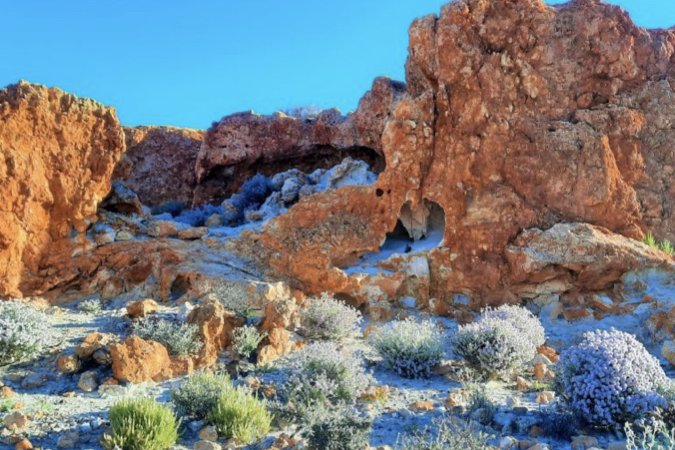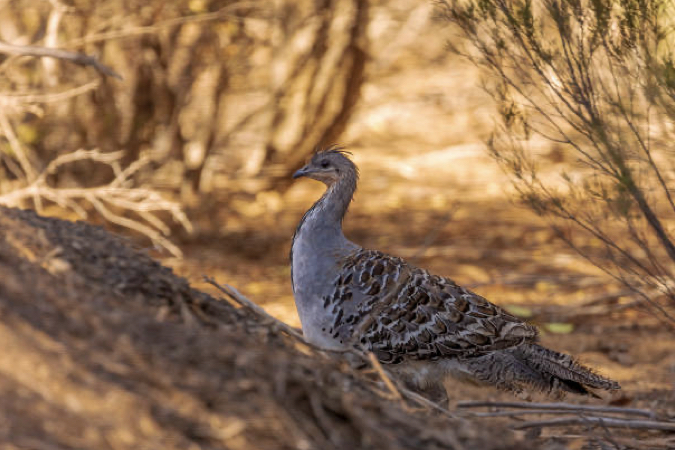



Narndee: Mallee Fowl Impact ProjectValidated by everclime
Key Info Story
Website
Social links
Project Story
The Narndee Landscape
This landscape was first identified by Forever Wild in 2018, as a place rich in biodiversity, cultural heritage, and vast, awe-inspiring wilderness landscapes. Incredibly, this part of the world has long been overlooked by conservation organisations and cultural heritage funding entities.
Biodiversity
After good winter rains, which only occur every few years, the wildlife on Narndee is abundant. The mulga woodlands and saltbush plains host flocks of thousands of budgerigars, and Mulga and Burke's parrots streak through the trees in pairs or small flocks.
The mulga woodlands share the soil with millions of desert wildflowers. The mulga trees themselves are fascinating simply due to their extraordinary adaptations. A true semi-arid plant, part of the acacia family, their roots can tap into water deep beneath the surface. They can live for an astonishing 300 years, and even the dead timber can stand for decades, hardened and cracked by the elements. These cracked, dead trees are home to many small reptiles and invertebrates.
When the winter rains have passed and the daytime temperatures climb towards 50 degrees celsius, the surface water disappears, along with the swirling flocks of budgerigars. Only the hardiest creatures remain, scurrying in and around their ancient mulga homes.
The mulga woodlands share the soil with millions of desert wildflowers. The mulga trees themselves are fascinating simply due to their extraordinary adaptations. A true semi-arid plant, part of the acacia family, their roots can tap into water deep beneath the surface. They can live for an astonishing 300 years, and even the dead timber can stand for decades, hardened and cracked by the elements. These cracked, dead trees are home to many small reptiles and invertebrates.
When the winter rains have passed and the daytime temperatures climb towards 50 degrees celsius, the surface water disappears, along with the swirling flocks of budgerigars. Only the hardiest creatures remain, scurrying in and around their ancient mulga homes.

Narndee is home to Mallee Fowl, a threatened and very unique species. The Mallee Fowls habitats have been lost due to agriculture, mining, roads and unsuitable fire regimes. They are listed as an endangered animal in NT, NSW and VIC, and are vulnerable in SA.

BeImpact
The mallee fowl is a threatened species, with a significant reduction in habitat across much of Australia. The species is affected by invasive predators including foxes and feral cats. Narndee Station appears to have a strong, viable breeding population of mallee fowl, though no data exists on nesting sites, hatching rates, population size, or critical habitat zones.
From a broader biological and species diversity perspective, this part of Australia is severely under-represented in data of known species and diversity. It is generally acknowledged that the region contains species new to science, and several rare and endangered plants. Species of particular significance that may or may not occur include the night parrot,
This project is a carbon co-benefit project applying a verifiable framework through BeImpact.
From a broader biological and species diversity perspective, this part of Australia is severely under-represented in data of known species and diversity. It is generally acknowledged that the region contains species new to science, and several rare and endangered plants. Species of particular significance that may or may not occur include the night parrot,
This project is a carbon co-benefit project applying a verifiable framework through BeImpact.

Project Description
The actions for the Be Impact Mallee Fowl project include:
1. Conduct aerial surveys of areas considered critical for mallee fowl, to identify nesting sites. Malleefowl are known to use the same nesting sites year on year, making large mounds in which they lay eggs.
2. Obtain a statistical figure of estimates malleefowl nest sites
3. Identify active nests, and locate field cameras to monitor mallee fowl activity and other activity, especially feral carnivores
4. Use cameras to try to identify hatching numbers
5. Collect data on adult birds
6. Conduct broader biological surveys from fixed points at locations of Narndee and Boodanoo., identified through known ecological data including land system. These surveys will use external experts in the relevant fields including botany, invertebrates, mammals and reptiles. These surveys will engage local Traditional Owners, and where appropriate as guided by the Traditional Owners, locate and map cultural sites.
7. Collate the survey data. Share with national databases. Inform property management strategies.
1. Conduct aerial surveys of areas considered critical for mallee fowl, to identify nesting sites. Malleefowl are known to use the same nesting sites year on year, making large mounds in which they lay eggs.
2. Obtain a statistical figure of estimates malleefowl nest sites
3. Identify active nests, and locate field cameras to monitor mallee fowl activity and other activity, especially feral carnivores
4. Use cameras to try to identify hatching numbers
5. Collect data on adult birds
6. Conduct broader biological surveys from fixed points at locations of Narndee and Boodanoo., identified through known ecological data including land system. These surveys will use external experts in the relevant fields including botany, invertebrates, mammals and reptiles. These surveys will engage local Traditional Owners, and where appropriate as guided by the Traditional Owners, locate and map cultural sites.
7. Collate the survey data. Share with national databases. Inform property management strategies.
